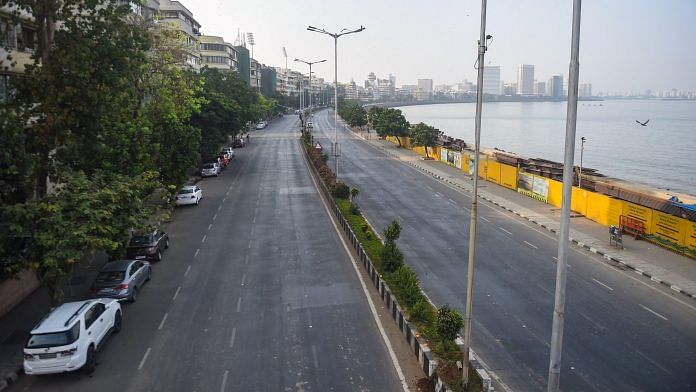New Delhi: The usually teeming streets of India’s commercial capital of Mumbai looked more like a scene from a post-apocalyptic movie last weekend.
On Marine Drive, which overlooks the Arabian Sea, the regular hustle and bustle was completely absent, while Dr. Dadabhai Naoroji Road, a thoroughfare that runs past one of the world’s busiest railway stations, was also eerily empty.
Maharashtra state, where Mumbai is located, is imposing a strict lockdown from late Friday until Monday morning this month and a curfew every night to curb a surge in Covid-19 cases in India’s biggest city. The deserted avenues, with few vehicles in sight, are a sobering reminder of last year’s national restrictions that threw the economy into the worst recession in decades.
Daily infections rose to a record 168,912 on Monday, and the total tally pushed past 13.5 million to overtake Brazil and be second to only the U.S. After seemingly getting the virus under control, the world’s second-most populous nation is facing a nastier wave that’s overwhelming hospitals, triggering vaccine shortages and forcing some states to impose stay-at-home orders.
That’s an ominous sign for India, where fuel consumption still hasn’t fully recovered from last year’s national lockdown that saw oil demand fall to the lowest since 2007. After dipping by about 2% in March from February, overall consumption of oil products looks set to extend declines this month.
Another set of images shows migrant workers crowding bus stations to head home to rural towns and villages in what threatens to become a repeat of last year’s exodus. While the current lockdowns aren’t as extensive as last March, there’s panic among workers and if more of them choose to flee major cities it will pose a setback to factories and infrastructure projects that rely on them.
Maharashtra, which accounts for about 15% of national GDP, has halted all non-essential services. Office staff at private companies have been asked to work from home, with some allowances made for banks and stock exchanges, while malls and restaurants have been ordered to shut through April.
The national capital of New Delhi has imposed a night-time curfew and is warning of more restrictions if its hospitals can’t cope with the uptick in virus cases. In Karnataka, home to India’s technology center of Bengaluru, curbs have also been announced and the state’s Chief Minister B.S. Yediyurappa has said a full lockdown may be coming if the situation doesn’t improve.
The restrictions have already started to hit India’s economy. Unemployment rose to 8.6% for the week ending April 11, up from 6.7% two weeks earlier, according to private data from Centre for Monitoring Indian Economy Pvt. Ltd. Urban areas are suffering more, with jobless rates nearing 10%.
Also read: Why India is buying more crude oil from Africa & North America and not Middle East
Gasoline, China
All of this bodes ill for energy demand. Consumption of diesel — the fuel that keeps India’s trucks, farms and factories running and accounts for almost 40% of oil-product sales — was around 3% below 2019 levels in March. Industry consultant FGE cut its growth estimates for key fuels this quarter to about 30% from a year earlier, compared with an earlier projection of almost 35%.
Police officials stand near the Taj Mahal Hotel during a weekend lockdown in Mumbai, India, on Saturday, April 10, 2021. Maharashtra has halted all non-essential services, ordered private companies to work from home, and shut malls and restaurants through April.
Gasoline, however, has so far defied the trend, with people opting to use cars and scooters when returning to work last year after the lockdown to avoid infection rather than diesel-guzzling buses or trains. Consumption of the motor fuel rose to four-month high in March and was 27% higher on a year-on-year basis and about 6% above 2019 levels. Whether that kind of demand can continue as more restrictions on movement are imposed remains to be seen.
In terms of the global impact on oil prices, a loss of demand from India — the world’s third-biggest crude importer — will certainly be felt. But the affect may be tempered by what’s happening in China, where Beijing’s success in tackling Covid-19 is pushing it closer to overtaking the U.S. and becoming the world’s biggest economy. Crude imports by the No. 1 oil buyer rose 9.5% in January to March from a year earlier, according to data released Tuesday.- Bloomberg
Also read: Deadly smoke set to return to kitchens as Modi govt cuts LPG subsidies




Deserted roads bring back nightmare of demand slump for Indian fuel companies, is reality but wrong headlining which displays lack of application of mind.
Knowing fully well that there are no established successful solutions to the situation a responsible headline should have been something that indicated the gravity of the situation with a glimmer of hope.
After the first wave the things did start looking better, ok we have the second wave and we will overcome that too.
Fortunately it is not possible to pin the blame on ruling or opposition.
Situation again grim like 2020